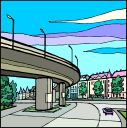How People Change Their Geography
Part
1: Changing Geography
When
you hear the word
geography, you tend to think of mountains and streams and
maps and compasses. But geography is bigger than that.
Geography is the world around you, wherever you are.
And
the more people live in a place, the more they want to
change it to suit their needs.
The
more people that live in one place, the bigger the
settlement tends to get. A town becomes a city, which
becomes a big city. Soon, smaller cities (called suburbs)
are forming on the outskirts of the big city. Before you
know it, you have a metropolitan area, with a total
population of hundreds of thousands of people.
How
do these people change their geography? Here are several
ways:
- They build more places
for people to live. All those people have to live
somewhere. Many live in houses. Many live in apartment
buildings. Others live in mobile homes.
- They build more
buildings that house stores and markets. Just about
everything you need can be found in either a store or a
market. Food comes from a market. Clothing and cars come
from stores. More people means more stores and markets.
And with those more stores and markets come more jobs, so
people can afford to buy food, clothing, and
cars.
 They
build roads to carry cars and trucks, so people can drive
from place to place.
They
build roads to carry cars and trucks, so people can drive
from place to place.- They build dams to
create reservoirs, which store water from rainfall and
nearby rivers and streams. More people means more water
needs.
- They plant more crops,
assuming that enough farmland is left. When a population
grows quickly, farmland is often turned into land for
housing and for stores and markets. It is sometimes
difficult for a city's supply of food to keep up with a
growing demand.
Next
page > What
Does It All Mean?
> Page 1, 2



 They
build roads to carry cars and trucks, so people can drive
from place to place.
They
build roads to carry cars and trucks, so people can drive
from place to place.
